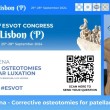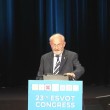
“Meniscal Tears in Horses”
MA, Vet MB, Cert EO, Dipl.ECVS, Hon. FRCVS (RCVS specialist in equine surgery)
The Liphook Equine Hospital Forest Mere Liphook Hampshire GU30 7JG
RL: Thank you very much for agreeing to speak to me on the diagnosis and treatment of meniscal tears in horses. I would like to use this opportunity to discuss the two cases of meniscal injury presented in the “case study” section of the website. In your opinion, what are the significant differences between the two cases presented and how do they affect the surgical outcome?
JW: Well, it seems that you have one horse (Horse 1) which suffers from an acute injury while Horse 2 appears to have chronic disease which is also emphasized by the changes in the cranial cruciate ligament. However I find it interesting that in Horse 1 you had no haemarthrosis, something that I would expect to see in such an acute case. Perhaps after all, this may indicate that the tear represents an aggravation of a more chronic presentation rather than an acute injury.
When we looked in our study (Walmsley et al. 2003) at the significance of cartilage lesions and radiographic changes we saw not surprisingly that horses with the latter had a much lesser chance of recovery. So in my book, Horse 2 does not have a great chance of returning to exercise.
RL: With respect to the surgical treatment of Horse 1, would you choose to debride the vertical tear or perform a partial meniscectomy?
JW: That is a difficult question to answer since there is no strong evidence to support one way or the other in horses. Human surgeons tend to preserve as much meniscus as possible. Once a tear is detached and the torn part becomes loose I do think that it is best removed as it is likely to cause more damage to the cartilage. I have tried to suture some of these vertical tears endoscopically but this is incredibly difficult and not really feasible in the horse.
RL: What is your preferred surgical instrument for debridement and resection?
JW: I do like to use an O’Connor punch for these lesions but I will also use meniscal knifes. Quite often you end up making a second instrument portal to grasp the torn tissue and apply tension while you are resecting at the same time. I also use the ArthroCare and Arthrex coblation units, which I like a lot as you can approach the tear well with the hook shaped tip, but you do need to be careful to avoid iatrogenic damage. In order to improve manoeuverability underneath the medial femoral condyle, I will also abduct the distal limb to open up the medial femorotibial joint.
RL: Have you had the opportunity to perform repeat arthroscopic evaluations of some of the tears that you have operated on?
JW: Yes I have but unfortunately not in enough numbers to allow an objective assessment. Generally speaking however tears do seem to “smooth off” once they have been debrided.
RL: In human surgery meniscal tears and their typical topographical location have been attributed to the poor vascularity of the axial border. Do you think this is also the reason for this type of tear to be more common in horses?
JW: It is very plausible that the predisposition for the axial border to develop lesions may well be for similar reasons in horses. Certainly biomechanical factors will play an important role too. One could argue that Horse 2, being a barrel racer, may have been predisposed to that sort of injury.
RL: Have you found the horse’s age or which meniscus is involved to affect the outcome?
JW: Unfortunately since the medial meniscus is much more commonly affected the numbers in our study did not allow making that comparison. Equally I can not comment on the influence of age. Nevertheless if numbers become sufficient those aspects may be interesting things to look at.
RL: Since there is recent evidence from experimental studies that intra-articular administration of bone marrow derived mesenchymal stem cells may be useful for treatment of meniscal injuries (Agung et al. 2006; Murphy et al. 2003), have you performed these additional treatment modalities?
JW: Yes, I have in a couple of cases. Especially in the younger horse, I believe this may be a valuable treatment option. In the older horse, the one that is battling against osteoarthritis, I am not so sure if there is much indication for this treatment. Human surgeons do not seem to talk about this treatment too much, which makes you wonder why they do not find it as wonderful as we do. I guess in time we will find out more.
RL: In your opinion, are there useful supportive treatments for meniscal injuries in the horse?
JW: I think that a restricted exercise regimen may play a more significant role during recovery than what we have previously thought. Certainly in people, physiotherapy plays a vital role in the post operative management. I seem to remember that a Swedish/Dutch research group has discovered evidence for weighted tendon boots to help develop strength in the upper limb musculature and I think those results will soon be published. This promises to be very interesting and will probably be an area to focus on in the future.
RL: Playing devils advocate, since it is known from your study that horses with grade II and grade III tears are 9 times more likely to show joint effusion and that the incidence of radiographic abnormalities increases significantly with the severity of the tear - should we still advise surgery in those horses that have joint effusion and radiographic changes, knowing that these horse’ have a poor to guarded outcome?
JW: How I see this is that knowing the stats allows us to inform the client accurately of the likely outcome. After all it remains the owners’ decision on how to proceed and it is not our role to make that decision for them by promoting surgery.
RL: How useful have you found ultrasonography to be in the process of making a diagnosis and what is your opinion on linear, horizontal anechogenicities within the meniscus as seen in the case study, since they have been suggested to represent horizontal tears?
JW: Indeed, I am very sceptical of these findings. It is almost as if you can create those lesions if you try hard enough. Personally, off the top of my head, most horizontal anechogenicities I have found to be artefacts. I certainly do perform ultrasonography routinely in all my cases but at the top of the diagnostic process has to be the response to intra-articular analgesia. In those cases that do improve following intra-articular analgesia and nothing abnormal is detected on radiographic and ultrasonographic examination I tend to medicate the joint with corticosteroids and hyaluronic acid first and if lameness persists 6 weeks later I will re-examine the horse with more aggressive treatment in mind. In those horses’ that show severe lameness and marked joint effusion I tend to get on with things, unless it is a really acute injury, in which case I wait for a week or so for the acute inflammation to calm down which will facilitate the arthroscopic exploration.
RL: Have you found meniscal injuries to be significantly associated with other soft tissue injuries of the stifle?
JW: Contrary to people, in which the terrible triad of knee injuries has been described (collateral ligament, anterior cruciate and meniscal injury), meniscal injuries in the horse do not typically seem to be associated with other lesions. I suspect that horses that suffer from an acute cruciate ligament rupture commonly are not operated on and are euthanased which consequently does not allow making the observation that other structures are also involved.
RL: How frequent are injuries of the caudal horn of the meniscus? Is it indicated to create a caudal arthroscopic approach to the femorotibial joints during each procedure?
JW: I think we now have about 600 cases in our data base and for the last 400 or so procedures I have always explored the caudal pouch of the medial femorotibial joint. So far I have seen very few lesions of the caudal portion – I believe in perhaps less than ten cases or so. I do not routinely go into the lateral caudal pouch as I find it much more difficult and also more invasive if you do not get it right the first time round.
RL: In the few cases with caudal meniscal lesions that you have observed, did you find lesions of the cranial portion at the same time?
JW: On the whole I believe tears that where seen in the caudal portion of the meniscus are an extension of a severe tear starting cranially. You can’t really see much in the caudal pouch - just the caudal border of the meniscus - so it has to be a significant injury to be seen there. We are actually just about to submit for publication a different approach to the caudal pouch coming from cranial and going along the intercondylar eminence into the caudomedial aspect of the medial femorotibial joint. It’s not easy and it only gives you a limited field of view but it adds to the current surgical exploration of the caudal pouch.
RL: Returning to the cases presented here - Can you explain the presence of the focal radiolucencies at the junction between the lateral trochlear ridge and lateral condyle of the femur in Horse 2?
JW: I have never really seen similar changes and so I do not know what they represent. They certainly do not seem to be at any soft tissue attachment site. Judging from the arthroscopic image, you do get a tremendous variation of tissue in that respective area so I am not quite sure what the significance of those irregularities really is.
RL: Last but not least do you attribute clinical significance to the fraying of the free edge of the medial cranial meniscal ligament seen in Horse 2?
JW: No - You do see that frequently enough to suggest that it is probably not a cause of clinical disease but may be wear and tear. Nevertheless I will clean it up occasionally for which I like to use coblation. Similarly you can sometimes see very mild fraying at the axial border of the medial meniscus in the older horse which I judge also to be wear and tear.
RL: Thank you very much for this very educational interview - It has been a pleasure speaking to you.
Walmsley, J.P., Phillips, T.J. and Townsend, H.G.G. (2003) Meniscal tears in horses: an evaluation of clinical signs and arthroscopic treatment of 80 cases. Equine vet. J. 35, 402-405.
Agung, M., Ochi, M., Yanada, S., Adachi, N., Izuta, Y., Yamasaki, T. and Toda, K. (2006) Mobilization of bone marrow-derived mesenchymal stem cells into the injured tissues after intraarticular injection and their contribution to tissue regeneration. Knee Surgery, Sports Traumatology, Arthroscopy 14, 1307.
Murphy, J.M., David, J.F., Ernst, B.H. and Frank, P.B. (2003) Stem cell therapy in a caprine model of osteoarthritis. Arthritis & Rheumatism 48, 3464.
JW: John WALMSLEY MA, Vet MB, Cert EO, Dipl.ECVS, Hon. FRCVS (RCVS specialist in equine surgery) The Liphook Equine Hospital
RL: Raphael Labens, MagMedVet, DEC-EQ, Cert ES(Orth), MVM, MRCVS Large Animal Surgery Resident North Carolina State University















